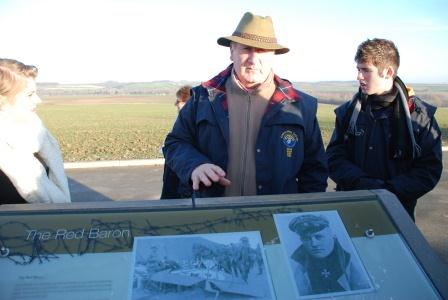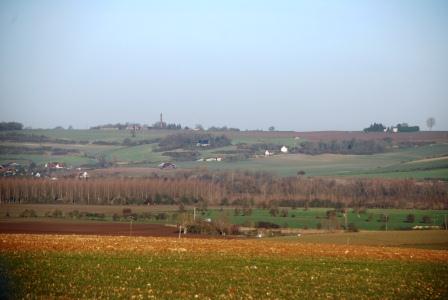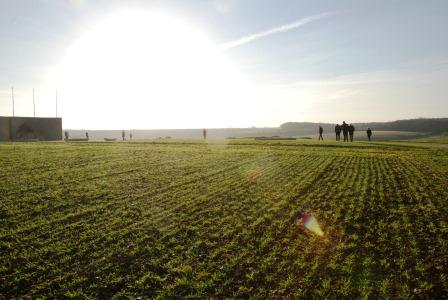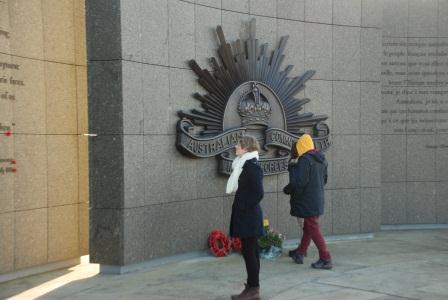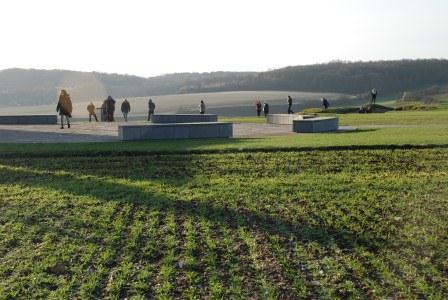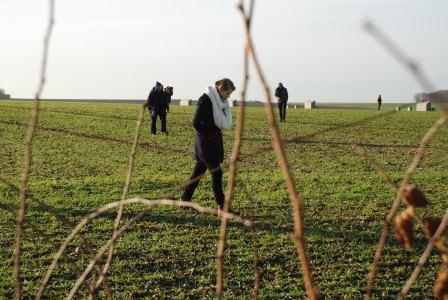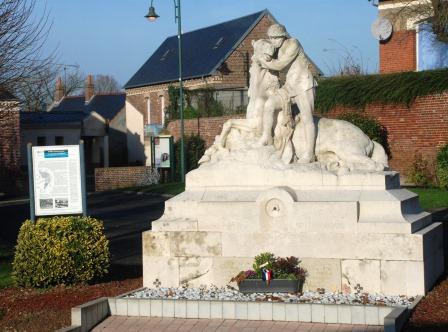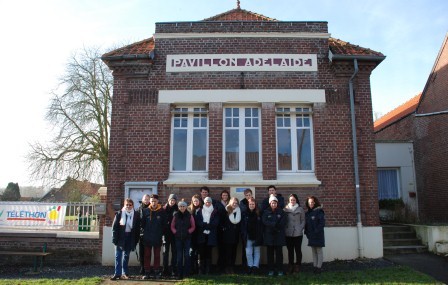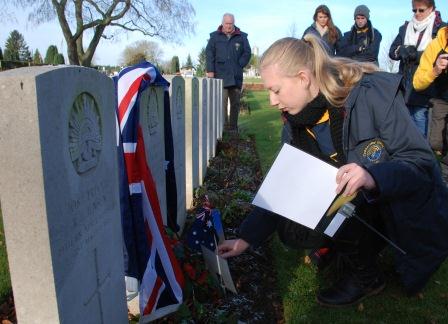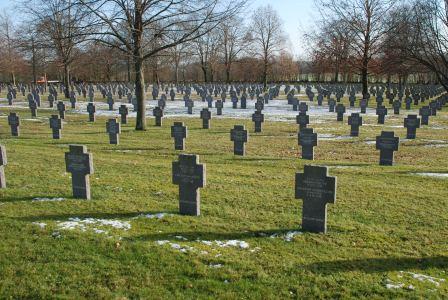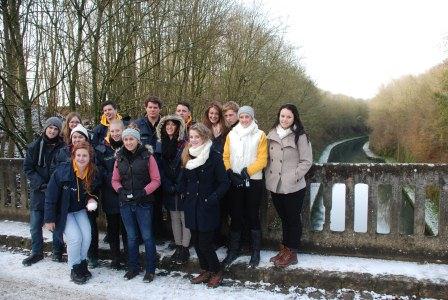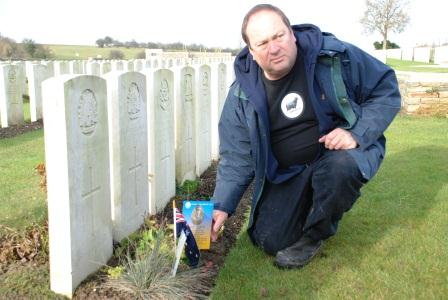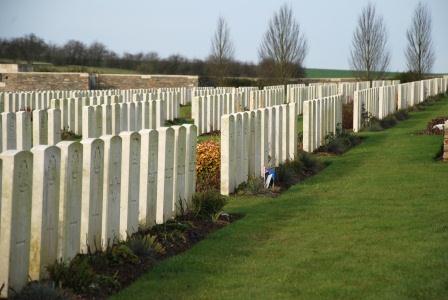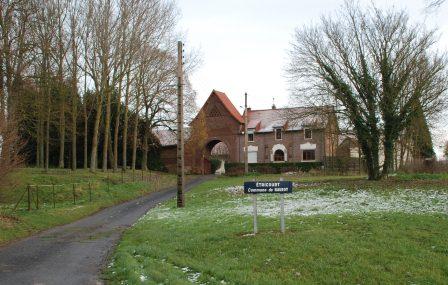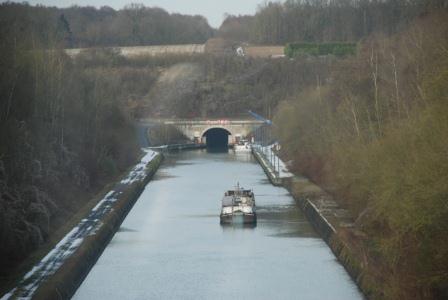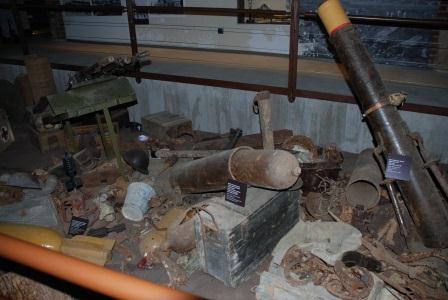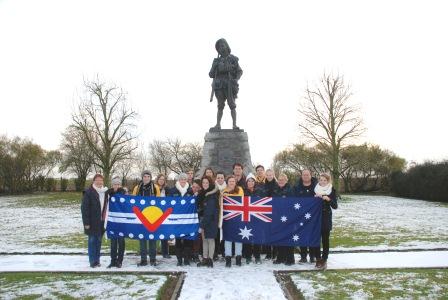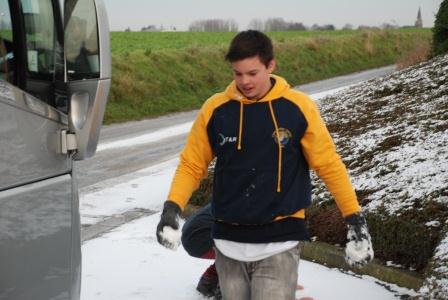6th December
Le Hamel to Bullecourt
Today started with the visit to Le Hamel that we had postponed from the afternoon before. This proved to be a great move, since while the weather was cold the sun was bright and gave a great view of the surrounding battlefields. It was here that on 4th July 1918 that General Sir John Monash launched an attack on this village. Many believe this to be the earliest effective use of all arms in a combined attack. Tanks were used to break through lines with infantry mopping up while aircraft flying over attacked specific targets and provided information to the ground troops. Other tanks were used to re-supply troops freeing up more men for the assault. Monash had planned and trained the men to the last detail and he had estimated the attack would take 90 minutes to achieve its objectives. In fact it took 93 minutes. The memorial to him is fitting but a search of the surrounding paddocks for shrapnel and other souvenirs proved fruitless. We the travelled to Dernancourt, a village that has links with South Australia, and the school was built with donations from SA children just as Victorian children supported the school at Villers-Bretonneux.
Our first commemoration of the day was Lauren's of Gordon Burnett at Peronne. Here we could see the battlefield of Mt. St. Quentin, another successful attack undertaken by very undermanned Australian battalions. It was during this battle that Lauren’s soldier, Gordon, fell.
Lauren Bagshaw
Commemorating Gordon John Burnett was one of the most emotional moments of my life. On the outside, it may have seemed less emotional than my commemoration of Douglas; this time tears didn’t turn my words into a completely different language. Though different circumstances and different connections caused that I felt just as devastated for Gordon as I did for Douglas. When I burst into tears during Douglas’, I was thinking of his family, perhaps because he was merely three generations back from me. For Gordon, I was also thinking of his family, except in this case, it was lack of. In my research, I was fortunate enough for a relative to send me some letters that Gordon sent home. Or, I suppose, that’s what I thought before I read them. The letters frequently contained heartbreaking pleas from Gordon for more contact from home. How anyone could face the barbarity of war and continue to fight despite the pain and isolation he must have felt seems beyond impossible; yet he did it. Gordon died in the victorious Australian counterattack at Mont Saint Quentin and there is no bigger inspiration to me than that.
We the had lunch in a supermarket car park, before a quick drive to Bellicourt. On the way we stopped at a German Cemetery which contained the remains of almost 45000 soldiers.
Lauren Bagshaw
Seeing our first German cemetery was really confronting for me, mainly because of the sheer size of it in the first place, but also because on some crosses, there were three names on each side and there was also a mass grave. If each soldier had his own grave, I’d be scared to walk around it for fear of it taking all day! When touring the Commonwealth cemeteries it is scary how many you see when you know you have barely seen any. With the German ones, the effect is almost the same except the enormity is presented to you in one devastating blow.
Once in Bellicourt we stopped to look at the Recquieval Bridge. This bridge crosses over the St. Quentin Canal and was captured by British troops on the 29th September 1918. There is a well-known picture of thousands of troops lining the banks of the canal being addressed by their commanding officer standing on the bridge. You can still some of the same damage on the bridge today!!!! Here is a link to that picture; http://waruntold.com/detail_thenandnow/19/
From here it was a short drive to the Bellicourt Military Cemetery where I remember my Great Uncle Frank at a grave of an unknown soldier. This is an important part of the trip for me and I appreciated the group indulging me as I told them the story behind this special place for me. Richard then drove along the road between Bellicourt and Nauroy where we believe that Frank was killed before driving onto Etricourt Farm. This is the place that the 77mm Krupp Field Gun that has been obtained by the Meningie RSL sub-branch was captured by Frank’s battalion, the 32nd, on the day after he was killed. As we drove down the road on which Uncle Frank was killed and where he was said to be have been buried, I had some mixed emotions. This was another significant part of my own journey but until now I had always shared each part with at least one member of my immediate family. For the first time I was on new ground but "alone" with 20 other people around me! I always thought that being on the trip without Hamish, Beth or Ali with me was going to be different but it was this short bus trip of less than 2 kms where it really hit home.
Lauren Bagshaw
After the emotional ceremony at Villers Bretonneux, it was quite uplifting to see Mr Jurg’s adopted unknown soldier. It gave me hope that though we don’t know where so many soldiers are, at least some of those names on a wall are being cared for in the grounds of a cemetery.
Then back across country through more Australian battlefields to Bullecourt, the site of two battles in April and May of 1917 that cost over 10,000 Australian casualties. The first of these was a complete disaster. It was something of an experiment with tanks being used to take down the wire and suppress the defenders in the first trenches, while the infantry consolidated the captured ground with less supporting artillery. However due to the lack of reliability of the tanks and some pretty shoddy planning the infantry left at zero hour with limited artillery support and only two tanks that were quickly taken out of action. While the Australians did manage to take some of the first and second trench lines they were unable to defend this ground against a determined counter attack and were forced to withdraw under heavy fire. This battle involved three of the AIF's most decorated officers in Albert Jacka, Harry Murray and Percy Black. Black lost his life while directing troops through a gap in the wire. His body was never recovered and he is commemorated on the wall at VB. First stop was at the new museum built with joint funding from the Australian and French governments and filled with material donated by the late Jean Letaille. The museum is well done, but doesn’t have the same earthy appeal that walking into Jean’s barn and house had. We then stopped at the Digger Memorial for a photo. Somehow a spontaneous snowball fight erupted as we made our way back to the bus, and it took some time to restore order. But we were soon back on the bus and on the way back to Amiens.
Demi Georgiou
Thiepval was actually incredible, to see all those names of lost soldiers on those pillars is unreal , it still hasn't really sunk in and it's still so hard to believe that all of these men and boys died and were never found not to mention the men with known graves. It makes you think 'was it really worth it?'My last commemoration was at VB and I'm kind of sad that I haven't got any more soldiers to commemorate. It really makes you feel so proud to learn about a soldier and commemorate him on behalf of those who can't. On a happier note, it snowed !!! A snow ball fight ensued which was quite hilarious with Julie, David, Mal and even Richard in the firing line !!!!
Amy Stott
The effects of this trip cannot be be felt or understood until you experience it yourself. I will never forget our amazing Aussie heros who gave their lives for our country.
Alana Standley
Today was the first day that we saw snow. The first snowball fight too!!! Was a good let down from a pretty busy day. Highlight for me was listening to Mr. Jurgs commemoration. It has inspired me to go home and dig deeper to possibly uncover stories my family may not know about our relatives in war.
Anne Molinaro
I found it really touching that Mal has adopted an unmarked grave in the place of his great uncle. I'd like to think that by some twist of fate that it is him.
Jack Bricknell
Today was a pretty early start and I just wanted to stay in bed but soon as I got outside the fresh air woke me up some.
Visiting the museums was pretty awesome because we got to use a voice walkthrough thing. All in all was a tiring but good day.
Julie Reece
Today was Mal’s day following the footsteps of his great uncle Frank Bartley through and around the Bellicourt sector. Frank’s story has evolved over the years we have worked together on CS and with the expertise of Rod and his trench maps and Richard’s patient driving through tiny back tracks, we were able to be at the place where Frank was probably killed. This year was the first time Mal had travelled on his own without any of his family on tour and was clearly finding today’s emotional journey difficult at times. The snow that had threatened yesterday was with us today …..bring on the snowball fights! Great release and huge fun when you can get that snow down the back of the driver!!! I fear revenge will be around the corner!!!!
